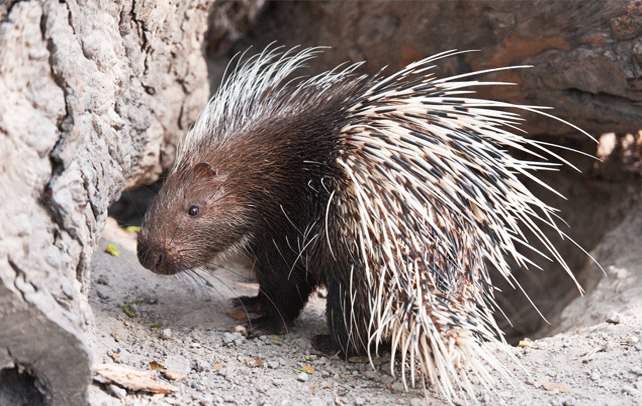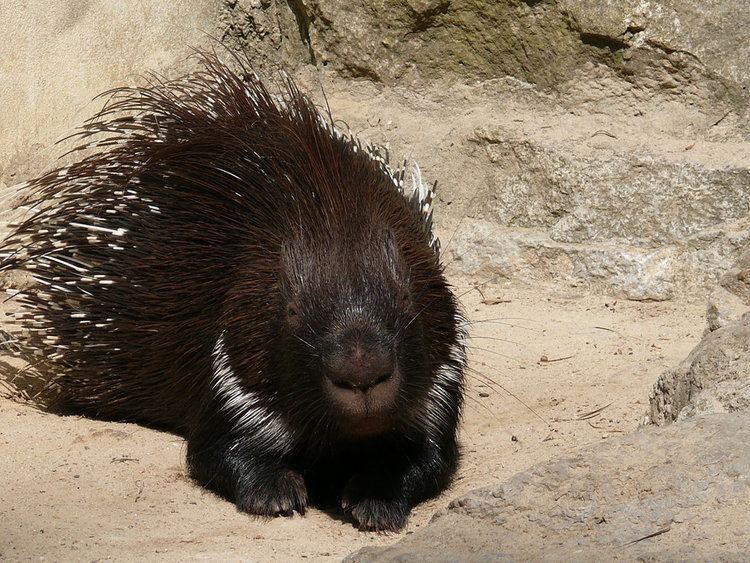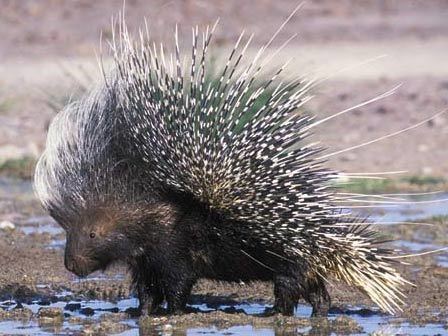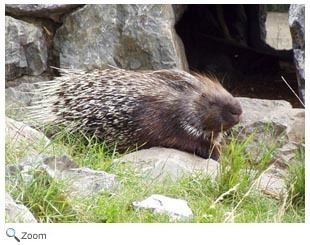Infraorder Hystricognathi Higher classification Hystricognathi | Phylum Chordata Suborder Hystricomorpha Scientific name Hystricidae Rank Family | |
 | ||
Lower classifications Hystrix, Crested porcupine, Brush‑tailed porcupine | ||
The Old World porcupines, or Hystricidae, are large terrestrial rodents, distinguished by the spiny covering from which they take their name. They range over the south of Europe and the Levant, most of Africa, India, and the maritime Southeast Asia as far east as Flores. Although both the Old World and New World porcupine families belong to the Hystricognathi branch of the vast order Rodentia, they are quite different and are not closely related.
Contents

Characteristics
Old World porcupines are stout, heavily built animals, with blunt, rounded heads, fleshy, mobile snouts, and coats of thick cylindrical or flattened spines, which form the whole covering of their bodies, and are not intermingled with ordinary hairs. The habits of most species are strictly terrestrial. They vary in size from the relatively small long–tailed porcupine with body lengths of 27.9 to 48 cm (11.0 to 18.9 in), and a weight of 1.5 to 2.3 kg (3.3 to 5.1 lb), to the much larger crested porcupines, which are 60 to 83 cm (24 to 33 in) long, discounting the tail, and weigh from 13 to 27 kg (29 to 60 lb).

The various species are typically herbivorous, eating fruit, roots, and bulbs. Some species also gnaw on dry bones, perhaps as a source of calcium. Like other rodents, they have powerful gnawing incisors, and no canine teeth. Their dental formula is 1.0.1.31.0.1.3

One or two (or, rarely, three) young are born after a gestation period between 90 and 112 days, depending on the species. Females typically give birth only once a year, in a grass-lined underground chamber within a burrow system. The young are born more or less fully developed, and the spines, which are initially soft, harden within a few hours of birth. Although they begin to take solid food within two weeks, they are not fully weaned until 13 to 19 weeks after birth. The young remain with the colony until they reach sexual maturity at around two years of age, and share the burrow system with their parents and siblings from other litters. Males, in particular, help defend the colony from intruders, although both sexes are aggressive towards unrelated porcupines.
These rodents are also characterized by the imperfectly rooted cheek-teeth, imperfect clavicles or collar-bones, cleft upper lip, rudimentary first front-toes, smooth soles, six teats arranged on the side of the body, and many cranial characters.
Species
Of the three genera, Hystrix is characterized by an inflated skull, in which the nasal cavity is often considerably larger than the brain case, and a short tail, tipped with numerous slender-stalked open quills, which make a loud rattling noise whenever the animal moves.
The crested porcupine (Hystrix cristata), a typical representative of the Old World porcupines, occurs throughout the south of Europe and North and West Africa. It is replaced in South Africa by the Cape porcupine, H. africaeaustralis, and in India by the Malayan porcupine (H. brachyura) and Indian (crested) porcupine (H. indica). The latter also lives throughout the Middle East.
Besides these large-crested species, several smaller species without crests occur in northeast India, and the Malay region from Nepal to Borneo.
The genus Atherurus includes the brush-tailed porcupines which are much smaller animals, with long tails tipped with bundles of flattened spines. One species is found in the Malay region and one in Central and West Africa. The latter species, the African brush-tailed porcupine (A. africanus), is often hunted for its meat.
Trichys, the last genus, contains one species, the long-tailed porcupine (T. fasciculata) of Borneo. This species is externally very similar to Atherurus, but differs from the members of that genus in many cranial characteristics.
Fossil species are also known from Africa and Eurasia, with one of the oldest being Sivacanthion from the Miocene of present-day Pakistan. However, it was probably not a direct ancestor of modern porcupines.
Species list
The extant species and fossil genera are:
